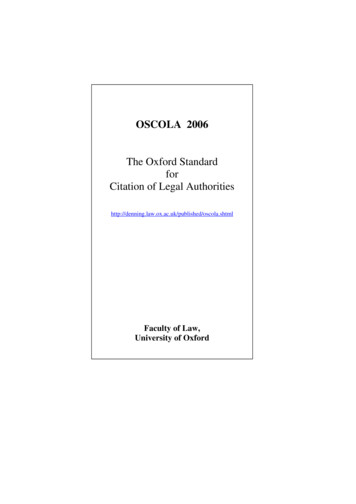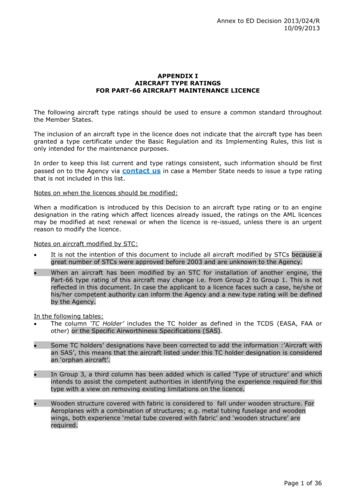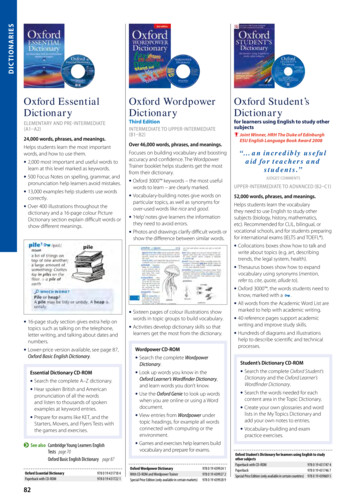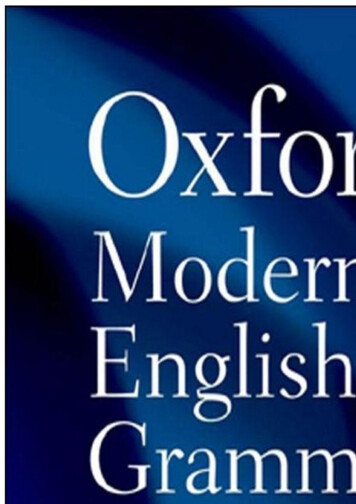
Transcription
OSCOLA 2006The Oxford StandardforCitation of Legal scola.shtmlFaculty of Law,University of Oxford
INTRODUCTION.3PART I GENERAL NOTES ON CITATION .51 Footnotes.52 Quotations.53 Cross-citation and cross-reference .64 Tables of cases, legislation, etc.75 Abbreviations.7PART II: CITING UK PRIMARY LEGAL SOURCES .8A CASES.81 Domestic cases .82 Scottish cases .133 European Community cases.134 European Court of Human Rights.145 Cases from other jurisdictions .14B LEGISLATION.151 Domestic primary legislation.152 Secondary legislation.163 EC legislation.174 Legislation from other jurisdictions .18PART III CITING LEGAL COMMENTARY.19A BOOKS AND ARTICLES .191 Books .192 Articles .20B OTHER SOURCES .211 General principles .212 Law Commission reports.223 Command papers .224 Hansard and parliamentary reports .225 Theses .236 Conference and other papers .237 Websites.238 Newspaper articles .249 Interviews .2410 Personal communication (inc email).24PART IV CITING INTERNATIONAL LAW SOURCES.25A TREATIES ETC .251 International treaties .252 Regional treaties.27B INTERNATIONAL CASES AND DECISIONS .281 International Court of Justice publications.282 Other sources of international decisions.29C NON-GOVERNMENTAL AND OTHER INTERNATIONALORGANISATIONS.321 United Nations documents.321
2 Regional bodies’ documents.363 International Yearbooks.364 Collected Courses of The Hague Academy of International Law .375 International Law Association .376 International Law Digests.37APPENDIX.381 Abbreviations in the names of law reports and journals .382 Abbreviations in case names .393 Abbreviations in footnotes.404 Abbreviations of names of international instruments.415 Guides for other jurisdictions .416 Other useful references .422
INTRODUCTIONThe Oxford Standard for Citation of Legal Authorities was devised by Professor PeterBirks, in consultation with students and faculty at Oxford University, and with OxfordUniversity Press and Hart Publishing. It is used by the Oxford University CommonwealthLaw Journal, and the editors of the Journal have contributed to its development. Thestandard is designed to facilitate accurate citation of authorities, legislation, and other legalmaterials.Professor Birks planned a revision of OSCOLA in 2004; after his untimely death in2004, we have revised the standard in consultation with students and faculty members andwith publishers. The aim has been to make changes (some of which Professor Birks had inmind) to promote the ‘consideration for the reader’ which he made a golden rule ofOSCOLA. Minor alterations and clarifications were made for the 2006 edition.We hope that the revised standard also shows the consideration for authors thatmotivated Professor Birks to design a uniform and simple standard for legal citation.Sandra Meredith and Timothy Endicott6 September 20063
4
PART I GENERAL NOTES ON CITATION1 FootnotesUse footnotes, not endnotes. Close footnotes with a full stop (or question mark, orexclamation mark). OSCOLA uses little punctuation otherwise, except single invertedcommas around journal article titles, and commas to separate items that would otherwiserun together. Where more than one citation is given in a single footnote, separate themwith semi-colons.The footnote marker should appear after the relevant punctuation in the text (if any)and normally at the end of a sentence. It may sometimes be necessary, for the sake ofclarity, to put the footnote after the word or phrase to which it relates. A quotation neednot be footnoted separately from the case or text from which it is derived if the two appearin the same sentence. Otherwise, separate notes should be used.Where a case name is given in the text, it is not necessary to repeat it in the footnote, asshown in the following example:It is well represented in the case law, perhaps most notably in theexpression of the no-conflict rule advocated by Lord Upjohn in Phipps vBoardman,31 and in the earlier Court of Appeal decision in Boulting vAssociation of Cinematograph, Television and Allied Technicians.32 In Boulting [or ‘inthe Boulting case’], Upjohn LJ said that the rule ‘must be applied realisticallyto a state of affairs which discloses a real conflict of duty and interest andnot to some theoretical or rhetorical conflict’.33 In Phipps, Lord Upjohndeveloped his view of the rule further by adding that there must be a ‘realsensible possibility of conflict’.34The relevant footnotes would appear thus:31 [1967] 2 AC 46 (HL).32 [1963] 2 QB 606 (CA).33 Boulting (n 32) 638.[or]34 Phipps (n 31) 124.33 ibid 638.Examples of citations of cases, legislation, books and journals are given in each sectionof OSCOLA. The Appendix includes a list of abbreviations that can be used in footnotes.2 QuotationsQuotations from other works, judgments, statutes, etc must be faithful to the original,except where it is necessary to change quotation marks from single to double, or vice versa.Do not change errors in the original or use [sic]. Any comments on the quotation shouldbe in the text or in a footnote.Incorporate quotations of three lines or less into the text, within single quotationmarks. Quotations within short quotations take double quotation marks. Punctuationfollows the closing quotation mark, unless it is part of the quotation. The superscriptfootnote marker comes last, after both the punctuation and the closing quotation mark.5
Present quotations longer than three lines in a double-indented single-spacedparagraph, with no further indentation of the first line. Do not use quotation marks,except for single quotation marks round quotations within quotations.Generally, use a colon to introduce a long quotation. However, when the lead-inmoves seamlessly into the quoted material a comma or no punctuation may be preferable.Begin with an ellipsis ( ) when a quotation starts mid-sentence, for example:Lord Radcliffe stated the position as follows: there is no precise formula that will determine the extent of detail calledfor when a director declares his interest or the nature of his interest. . Hisdeclaration must make his colleagues ‘fully informed of the real state ofthings’ . If it is material to their judgment that they should know notmerely that he has an interest, but what it is and how far it goes, then hemust see to it that they are informed.16 (emphasis added)Indicate omissions from a quotation with an ellipsis, and any change of emphasis in aparenthetical clause after the citation by use of ‘(emphasis added)’. If you omit citations orfootnotes from a quotation, put ‘(citation(s) omitted)’ or ‘(footnote(s) omitted)’ after thesource. To attribute a quotation within a quotation to its original source, omit the footnotefrom the quotation, and state the original author’s citation in your footnote, as follows: the House of Lords also concluded that the civil standard of proof (onthe balance of probabilities) should be applied in such a way as to besensitive to the ‘seriousness of the matters to be proved and theimplications of proving them,’ which in effect means proof beyondreasonable doubt (i.e. the criminal standard).2727 Andrew Ashworth ‘Social Control and “Anti-Social Behaviour”: The Subversion ofHuman Rights’ (2004) 120 LQR 263, 276, citing Clingham and McCann [2003] 1 AC 787[83] (Lord Hope of Craighead).3 Cross-citation and cross-referenceCross-citation directs the reader to source material cited in another footnote. Crossreference directs the reader to some other passage in your work. Both techniques causework for the reader; use them only when that work will be rewarding. Do not cross-cite toa footnote in a different chapter. In a cross-citation, briefly identify the case, book or otheritem and specify the note in which the full citation is to be found:35 Ashworth (n 27).For repeated citations of a case, you can simply give the full citation each time, or usecross-citation; in either event, you can abbreviate the names of the parties after the firstcitation. So if you cite Barrett v Enfield LBC [2001] 2 AC 550 (HL) in footnote 1, cite itafterwards in whichever of the following ways is most convenient:5 Barrett v Enfield LBC [2001] 2 AC 550 (HL).5 Barrett v Enfield LBC (n 1).5 Barrett (n 1).6
On Latin gadgets: do not use supra, infra, ante, id, op cit, loc cit, contra, as they are notwidely understood. ‘Ibid’, which is an abbreviation of ‘ibidem’ and means ‘in the sameplace’, can be used to repeat a citation in the immediately previous note. Standing alone,‘ibid’ means strictly ‘in the very same place’ while ‘ibid 345’ means ‘in the same work butthis time at page 345’. In general it is equally possible to repeat the immediately previouscitation without using ‘ibid’: Ashworth (n 27) 265–67’ thus does the trick even in n 28. Donot switch back and forth from one to the other. Similarly, use ‘cf’ for ‘compare’: ‘Cf.Ashworth (n 27) 265–67.’Cross-references to points of substantive discussion elsewhere in your work mayperform a useful function. But avoid sending the reader off to another part of the textwhen a short point could as easily be restated. Never make a cross-reference that will bedifficult for the reader to find. ‘See above’ is worse than useless. ‘See chapter VII above’ isno better. A good cross-reference takes the reader straight to the very place: ‘109’ or,within the chapter, ‘text to n 32’. Do not cross-refer to ‘Chapter 6A2(c)’ unless you haverunning headers on each page showing the sequence of sub-headings. Use ‘see ’ onlywhen you actually want the reader to look at the place indicated, for example ‘See 109,above’, or ‘See n 27, below’.Remember that pagination changes from draft to draft, especially in preparation forpublication. A reference to 198 is not much use when 198 has become 132. To save time,you can cross-refer to footnote markers, which change much less: ‘Text to n 107 in chapter7’ should sufficiently pin down the location.4 Tables of cases, legislation, etcIn a book or thesis, compile the table(s) of cases (generally located in the preliminarypages) alphabetically. Unless there are very few cases, divide the tables into separatesections for separate jurisdictions. Arrange EC cases (distinguishing between ECJ, CFI andCommission cases) in chronological and numerical order. Where there are sufficientinternational cases to merit it, sub-divide the table with headings for each individualcountry.Alphabeticize cases by the significant name. Thus, ‘In re the Estate of Farquar’ or ‘ReFarquar’s Estate’ should be tabled under ‘Farquar’s Estate, Re’.Compile shipping cases and trade mark cases under the full case name, but insert anadditional entry in the tables under the name of the ship or the trade mark, with a crossreference to the full name.Compile tables of legislation with similar divisions as to jurisdiction.5 AbbreviationsIn an article, avoid unfamiliar abbreviations and define any that you use in a footnote or inthe text. In a thesis or book, define abbreviations in a ‘List of Abbreviations’ in thepreliminary pages. But you need not define an abbreviation that is part of everyday usage(eg, ‘eg’ or ‘etc’). And every lawyer can be taken to know some additional abbreviations.The Appendix provides tables of common abbreviations that need no definition.7
PART II: CITING UK PRIMARY LEGAL SOURCESA CASES1 Domestic cases(a) General principlesA case citation identifies where a report of the judgment can be found. For example,Pepper v Hart [1993] AC 593 (HL)indicates that the case involving Pepper and Hart, decided by the House of Lords, is to befound in the 1993 volume of the series of the Law Reports called the ‘Appeals Cases’ atpage 593.Dates are put in square brackets when the volume uses the date to identify itself. Datesin round brackets are additional information about the date of the judgment. For example,the citationPepper v Hart (1993) 143 NLJ 17indicates that there is also a report of this case in volume 143 of the New Law Journal atpage 17, and that it was published in 1993. This practice with square and round bracketsapplies to journals as well as law reports.Use italics for the names of the parties, with an unpunctuated italic v to separate thenames of adverse parties. Use roman for the rest of the citation. Use punctuation onlywhere its omission would cause information to run together. Hence ‘QB’ rather than‘Q.B.’and ‘WLR’ rather than ‘W.L.R.’. Use commas to separate numbers that mightotherwise run together, such as the first page of a report and a pinpoint (on pinpoints, seeparagraph (f), below). If you give parallel citations, use commas to separate the citations.Indicate the court before the pinpoint. Use ‘(QB)’, ‘(Ch)’, and ‘(F)’ for the divisions ofthe High Court. The Commercial Court within the QBD is ‘(Com Ct)’. A Scottish case inthe House of Lords is indicated by (HL Sc). Citations before 1865 do not require the court,nor do citations that include a neutral citation.(b) Neutral citationsSince 2001, judgments in the House of Lords, Privy Council, Court of Appeal andAdministrative Court have been issued with neutral citations. This system was extended toother parts of the High Court in 2002. Judgments with neutral citations are freely availableon the British and Irish Legal Information Institute website (www.bailii.org).Neutral citations identify judgments independently of any series of reports, and citeonly parties, year of judgment, court and case number. For example,Rottman v MPC [2002] UKHL 20identifies the 20th judgment in 2002 in the UK House of Lords. EWHC and EWCAidentify the England and Wales High Court and Court of Appeal respectively. These8
abbreviations are generally followed by an abbreviation indicating the court or division (egAdmin, Ch, Crim, Pat).Give the neutral citation first, followed by a citation of the best report. For informationabout the best report, see paragraph (c), below.For an unreported case with no neutral citation, cite the court and the date of thejudgment. Include a comma after the party names if required to stop them running intothe court or a newspaper title.The following are examples of correctly cited cases (post-1865):Johnson v Royal Mail Steam Packet Co (1866) LR 3 CP 38 (CCP)Donoghue v Stevenson [1932] AC 562 (HL Sc)Bigos v Bousted [1951] 1 All ER 92 (KB)Berk v Hair (DC 12 September 1956)New Zealand Shipping Co Ltd v Satterthwaite (AM) & Co Ltd (The Eurymedon)[1975] AC 154 (PC)Re Bourne [1978] 2 Ch 43 (Ch)Home Office v Dorset Yacht Co Ltd [1970] AC 1004 (HL)Powick v Malvern Wells Water Co, The Times 28 September 1993 (QB)British Steel plc v Customs and Excise Commissioners [1997] 2 All ER 366 (CA)Capital & Counties plc v Hampshire CC [1997] QB 1004 (CA)Barrett v Enfield LBC [2001] 2 AC 550 (HL)Dextra Bank v Bank of Jamaica [2002] 1 All ER (Comm) (PC) 193R v G [2003] UKHL 50, [2004] 1 AC 1034For judicial review applications it is not necessary to include ‘on the application of’ inthe party names. Simply cite as follows:R (Roberts) v Parole Board [2004] EWCA Civ 1031, [2005] QB 410For judicial review applications prior to 2001, cite in the following way:R v Lord Chancellor, ex p Witham [1998] QB 575 (QB)Some reports series, such as the Reports of Patent Cases, cite to a case number ratherthan to a page number:Thompson Holidays Ltd v Norwegian Cruise Lines Ltd [2003] RPC 32When citing more than one case in one footnote, arrange them in chronological orderseparated by semi-colons:9
Berk v Hair (DC 12 September 1956); New Zealand Shipping Co Ltd v Satterthwaite (AM) &Co Ltd (The Eurymedon) [1975] AC 154 (PC); R v Leeds County Court, ex p Morris [1990] QB523 (QB) 526–29.45(c) Which is the best report?The most authoritative reference is to the official Law Reports series (Appeals Cases,Chancery, Family, Queen’s Bench etc). If a case is not reported in the Law Reports, cite theWeekly Law Reports. Failing that, cite the All England Reports.Note on the Weekly Law Reports: like the official Law Reports, they are published bythe Incorporated Council of Law Reporting (www.lawreports.co.uk), but they do notinclude argument of counsel. Volume 1 of the WLRs contains cases that the Council doesnot plan to include in The Law Reports, while Volumes 2 (January to June) and 3 (July toDecember) cover the cases that will be republished in the Law Reports. Cite 2 WLR or 3WLR only if the case has not yet come out in the Law Reports; there may be changes in theLaw Reports version.In certain specialist areas, even where a case is reported in the Law Reports or AllEngland Reports, it may be preferable to refer to a relevant specialist series, such as Lloyd'sLaw Reports, Family Law Reports, Industrial Cases Reports, or Reports on Patent Cases.In the first instance of such a citation a short reason should be given for the departurefrom normal practice. A report in The Times newspaper should only be cited if there is noother published report.(d) Cases before 1865For pre-1865 cases, cite both the nominate reports and the English Reports, divided by acomma unless there is a pinpoint, in which case by a semi-colon:Boulton v Jones (1857) 2 H&N 564, 157 ER 232Henly v Mayor of Lyme (1828) 5 Bing 91, 107; 130 ER 995, 1001If you need to identify the court, spell it out in the text: ‘The Court of Common Pleastook the view that ’.(e) Case namesWhere there are multiple parties, name only the first claimant and first defendant. Wherethe parties are individuals, omit given names and initials. Abbreviate common words andphrases: use AG for Attorney General, BC for Borough Council, Co for Company, DPPfor Director of Public Prosecutions and so on (see the Appendix for abbreviations).Cite a case name in full in the first mention in the text or footnote; it may be shortenedthereafter. Thus, ‘in Glebe Motors plc v Dixon-Greene’ can be shortened to ‘in the Glebe Motorscase’ (or ‘in Glebe Motors’). In shipping cases, you can use the name of the ship instead ofthe full case name (for example, The Eurymedon). In criminal cases it is conventional toabbreviate ‘in R v Caldwell’ to ‘in Caldwell’. In civil cases that kind of abbreviation is alsoacceptable, subject to the warning that the name chosen must be that which stands first inthe full name of the case.Use Re in preference to In re, In the matter of, etc: Re the Companies Act 1985 rather than Inthe matter of the Companies Act 1985, and Re Farquar’s Estate instead of In re the Estate of10
Farquar. Abbreviate Ex parte to Ex p with a capital E at the beginning of a case name but inlower case elsewhere. The p has no full stop. Generally, do not include expressions such asand another, which may appear in titles in law reports.(f) PinpointWhen citing a case as authority for a proposition, add a pinpoint if possible, to indicateexactly where the passage on which you are relying is to be found. Where the citation endswith the identification of a court by its acronym in brackets, the pinpoint follows thatattribution without any comma. Where there is no such attribution, or where there is morethan one pinpoint, insert a comma to prevent the numbers running together. Where thepinpoint reference is to the first page of the report, repeat the page number:Beattie v E & F Beattie Ltd [1938] Ch 708 (CA) 708Cooper v McKenna, ex p Bishop [1986] WLR 327 (CA) 328, 333R v Leeds County Court, ex p Morris [1990] QB 523 (QB) 526–29El Ajou v Dollar Land Holdings [1993] 3 All ER 717 (Ch) 738, 739–40Associated Newspapers Ltd v Wilson [1995] 2 AC 454 (HL) 479 (Lord BrowneWilkinson)If the case has numbered paragraphs, use the paragraph number in square brackets as apinpoint, rather than the page number:47 Re A (Conjoined Twins: Surgical Separation) [2000] EWCA Civ 401, [2001] Fam 147 [20],[25]; Costello v Chief Constable of Derbyshire Constabulary [2001] EWCA Civ 381, [2001] 1 WLR1437 [1]–[30].(g) Attributions to judgesIf it is useful for your purposes to name the deciding judge, use the judge's surnamefollowed by the conventional abbreviation identifying their judicial office. Do not usehonorifics such as 'the Honourable'. A High Court judge (a Justice of the High Court) iscalled 'Mr [or Mrs or Miss] Justice Smith' (abbreviated 'Smith J'). A Court of Appeal judge(a Lord Justice of Appeal or Lady Justice of Appeal) is called 'Lord Justice Smith' or 'LadyJustice Smith' (abbreviated 'Smith LJ'), unless the judge is a peer, in which case he is called,for example, 'Lord Denning'. So, for example,In Lippiatt v South Gloucestershire Council,77 Evans LJ stated that A House of Lords judge (a Lord of Appeal in Ordinary, more commonly called a LawLord) is called 'Lord Smith' or, in the case of the first woman in the House of Lords,'Baroness Hale'. Abbreviated forms are not used for Law Lords. If a Law Lord's territorialqualification is stated in the report of a decision (eg Lord Scott of Foscote), you can omitthe qualification (or use it the first time you mention the judge, and omit it subsequently).The name of the Lord Chief Justice is abbreviated as 'Lord Woolf CJ' and the Masterof the Rolls as 'Lord Woolf MR'. The Lord Chancellor can be abbreviated similarly as'Lord Irvine of Lairg LC'. If a judge has been elevated to a new appointment since thedecision of the case you are citing, you do not need to say 'as he then was'. If you are11
naming several Law Lords, do not say 'Lords Smith and Jones', but 'Lord Smith and LordJones'.In footnotes, add the name in brackets at the end of the citation. Do not use the oldfashioned per:57 [1999] All ER 400 (HL) 411 (Lord Steyn).(h) Different case nameIf a case appears under a different case name at any point in its history (that differencebeing more than a mere reversal in the names of the parties), the earlier and different namemay be introduced by the phrase ‘sub nom’.South Yorkshire Transport Ltd v Monopolies and Mergers Commission [1993] 1WLR 23 (HL) sub nom R v Monopolies and Mergers Commission, ex p SouthYorkshire Transport Ltd [1992] 1 WLR 291 (CA)(i) Popular case namesPopular names for cases may be used. Give the popular name in parentheses after theinitial full citation, and then use the popular name in subsequent citations.Mirage Studios v Counter-feat Clothing Co Ltd [1991] FSR 145 (Ninja Turtlescase)Case C-376/98 Germany v Parliament and Council [2000] ECR I-8419(Tobacco Advertising case)(j) Case historyThe subsequent history of a case may be indicated after the primary citation byabbreviating ‘affirmed’ to ‘aff’d’ and ‘reversed’ to ‘rev’d’. These abbreviations refer to theprimary decision.R v Adomako [1994] QB 302, aff’d [1995] 1 AC 171(h) Case notesTreat case notes with titles as journal articles. Where there is no title, put the parties inquotation marks, and add (case note) after the title. For example:A Ashworth, ‘R (Singh) v Chief Constable of the West Midlands Police’ (case note)[2006] Crim LR 441Provide the same information in a footnote, except where the parties are named in thetext, in which circumstance, cite:A Ashworth, (case note) [2006] Crim LR 441The case should be included in the Table of Cases, citing its best report.12
2 Scottish casesCitations of the official Scots reports do not use brackets. Examples of cases from theScottish Series of Session Cases from 1907 and Justiciary Cases from 1917 follow:Hughes v Stewart 1907 SC 791Corcoran v HM Advocate 1932 JC 42It is usual to refer to Justiciary Cases simply by the name of the panel (or accused),thus, Corcoran.3 European Community cases(a) European Court of Justice and Court of First InstanceFor cases in the European Court of Justice (ECJ), if possible, cite the official reports, theEuropean Court Reports (ECR). If an ECR reference is not available, the second bestreport is usually the Common Market Law Reports (CMLR). You may also cite the LawReports, the WLR or the All ER in preference to the CMLR. For an unreported case, citethe relevant notice in the Official Journal (OJ). If not yet reported in the OJ, then cite thecase number, case name, court, and date of judgment.Since 1989, cases have been numbered and prefixed according to whether they areregistered at the ECJ or the Court of First Instance (CFI). ECJ cases a
On Latin gadgets: do not use supra, infra, ante, id, op cit, loc cit, contra, as they are not widely understood. 'Ibid', which is an abbreviation of 'ibidem' and means 'in the same place', can be used to repeat a citation in the immediately previous note. Standing alone,











